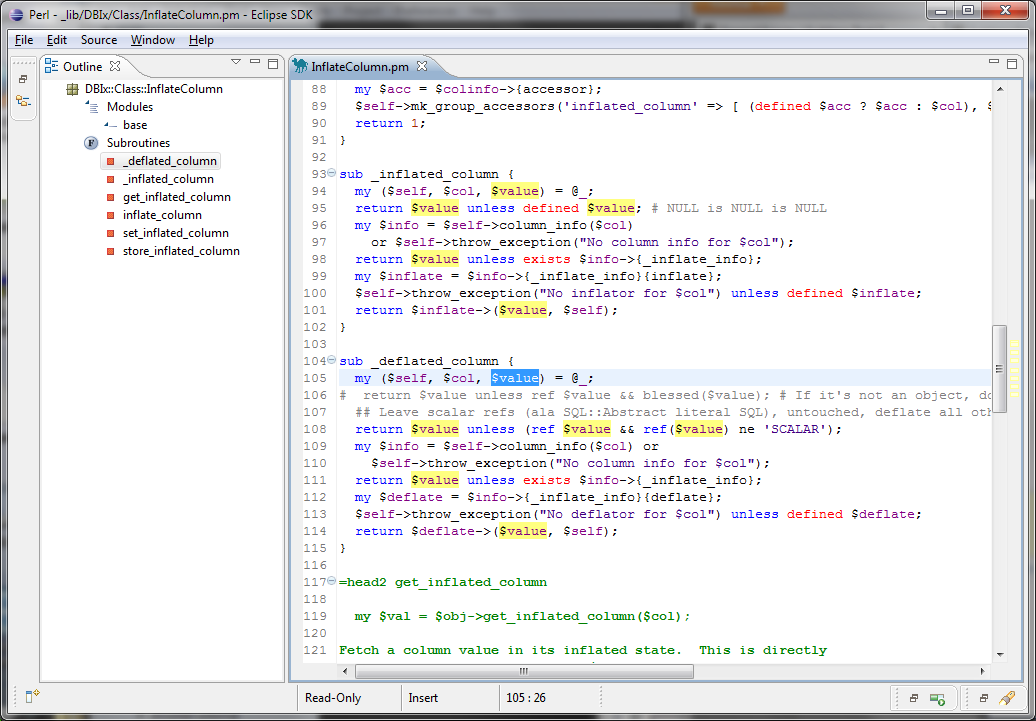
 When viewing a file in Folders, store the view position even though the file has not been opened for editing.
When viewing a file in Folders, store the view position even though the file has not been opened for editing.

 Trimming white spaces can make lose undo history
Trimming white spaces can make lose undo history

 External open: colon in filename
External open: colon in filename
External opening of a file (i.e. from file browser), if the filename or path contains a colon (:), does not work.
sublime_text lab\:\ 1.txt
sublime_text "lab: 1.txt"
both open an empty buffer, named "lab". I guess the part after ":" is interpreted as a line number to go to

 Setting to ignore certain package on specific syntax
Setting to ignore certain package on specific syntax
It would be nice to have a User Setting to ignore specific packages when using a specific syntax.

 Find/Replace alternative
Find/Replace alternative


 Sublime should accept wildcard paths on command line on windows
Sublime should accept wildcard paths on command line on windows

 Idea: Syntax highlighting defines sidebar colors and scrollbar styles
Idea: Syntax highlighting defines sidebar colors and scrollbar styles

 "Goto Anything" should use the selected text as default input
"Goto Anything" should use the selected text as default input

 Bug with more than 99 conditional inserts in a snippet
Bug with more than 99 conditional inserts in a snippet
Snippets with more than 99 conditional insert work incorrect: all the conditions with more than two digits in they are those to digits.
Here is a snippet to run through ST's console:
view.run_command("insert_snippet", {"contents" : "snippet: $1${1/^(1$)?(2$)?(3$)?(4$)?(5$)?(6$)?(7$)?(8$)?(9$)?(10$)?(11$)?(12$)?(13$)?(14$)?(15$)?(16$)?(17$)?(18$)?(19$)?(20$)?(21$)?(22$)?(23$)?(24$)?(25$)?(26$)?(27$)?(28$)?(29$)?(30$)?(31$)?(32$)?(33$)?(34$)?(35$)?(36$)?(37$)?(38$)?(39$)?(40$)?(41$)?(42$)?(43$)?(44$)?(45$)?(46$)?(47$)?(48$)?(49$)?(50$)?(51$)?(52$)?(53$)?(54$)?(55$)?(56$)?(57$)?(58$)?(59$)?(60$)?(61$)?(62$)?(63$)?(64$)?(65$)?(66$)?(67$)?(68$)?(69$)?(70$)?(71$)?(72$)?(73$)?(74$)?(75$)?(76$)?(77$)?(78$)?(79$)?(80$)?(81$)?(82$)?(83$)?(84$)?(85$)?(86$)?(87$)?(88$)?(89$)?(90$)?(91$)?(92$)?(93$)?(94$)?(95$)?(96$)?(97$)?(98$)?(99$)?(100$)?(101$)?(102$)?(103$)?(104$)?(105$)?(106$)?(107$)?(108$)?(109$)?(110$)?(111$)?(112$)?.*/(?1:=1)(?2:=2)(?3:=3)(?4:=4)(?5:=5)(?6:=6)(?7:=7)(?8:=8)(?9:=9)(?10:=10)(?11:=11)(?12:=12)(?13:=13)(?14:=14)(?15:=15)(?16:=16)(?17:=17)(?18:=18)(?19:=19)(?20:=20)(?21:=21)(?22:=22)(?23:=23)(?24:=24)(?25:=25)(?26:=26)(?27:=27)(?28:=28)(?29:=29)(?30:=30)(?31:=31)(?32:=32)(?33:=33)(?34:=34)(?35:=35)(?36:=36)(?37:=37)(?38:=38)(?39:=39)(?40:=40)(?41:=41)(?42:=42)(?43:=43)(?44:=44)(?45:=45)(?46:=46)(?47:=47)(?48:=48)(?49:=49)(?50:=50)(?51:=51)(?52:=52)(?53:=53)(?54:=54)(?55:=55)(?56:=56)(?57:=57)(?58:=58)(?59:=59)(?60:=60)(?61:=61)(?62:=62)(?63:=63)(?64:=64)(?65:=65)(?66:=66)(?67:=67)(?68:=68)(?69:=69)(?70:=70)(?71:=71)(?72:=72)(?73:=73)(?74:=74)(?75:=75)(?76:=76)(?77:=77)(?78:=78)(?79:=79)(?80:=80)(?81:=81)(?82:=82)(?83:=83)(?84:=84)(?85:=85)(?86:=86)(?87:=87)(?88:=88)(?89:=89)(?90:=90)(?91:=91)(?92:=92)(?93:=93)(?94:=94)(?95:=95)(?96:=96)(?97:=97)(?98:=98)(?99:=99)(?100:=100)(?101:=101)(?102:=102)(?103:=103)(?104:=104)(?105:=105)(?106:=106)(?107:=107)(?108:=108)(?109:=109)(?110:=110)(?111:=111)(?112:=112)/m}"})
Run it, then try to write simple numbers like `1` or `4`, and then write `10` or `11` — you would see how all the conditional inserts starting with those numbers would be placed like this:
10=100=1001=1012=1023=1034=1045=1056=1067=1078=1089=109
That's not something critical, 'cause we could split this tabstop to multiple ones each containing 99 conditions, but there is still a bug.

 Mark Occurences (like Eclipse)
Mark Occurences (like Eclipse)
Each time I select a word, all occurrences are highlighted in the document, and the distribution of occurrences is shown in the marker panel that runs alongside the vertical scroll bar.
Sublime Text 2 has a similar feature activated using Find - but it would be nice to have the feature activated all the time and the distribution of occurrences shown.
Example screenshot:


 Display Photoshop style color picker in css files after the "#" character is pressed
Display Photoshop style color picker in css files after the "#" character is pressed
It would be very nice if a Photoshop style color picker was displayed when the "#" character is pressed, denoting that you are about to enter a hexadecimal value, or when rgba() is typed. It would be particularly nice when designing right in the browser/sublime text.

 hiding files from folder view
hiding files from folder view
Hi, here's an idea I'd like to ask for:
I'm developing a RoR application which has the normal Rails directory structure. It also uses quite a bit client-side stuff with Backbone.js which means there's another MVC structure within assets/javascript hierarchy, not to mention all the other stuff that keeps filling up the hierarchy. It also uses config/locales to do I18n, which I also need to edit sometimes.
I love the folders view sidebar and I would actually like to use it to navigate these files. But the directory structure tends to be so crowded that jumping from one file to another from there is a chore, since opening the directory tree for some files will cause it to fill with all the other files I'm not needing and forces me to scroll back and forth. Also, with many files and folders the structure gets so wide that the visibility of what's inside of which folder gets harder to see.
Could there be (is there?) a feature to hide everything from the folders view sidebar except the directory structure (for RoR development, especially with Backbone inside assets/javascript, the directory structure IS relevant information) and files I have opened as tabs, for example? Of course, it needs to be easily toggleable when I want to open some new file...

 Fuzzy search snippet tab triggers
Fuzzy search snippet tab triggers
Example: Let's say I have a snippet with a tab trigger named this:
left triangle black
This snippet creates a Left-facing, Black Triangle HTML entity for me. The problem with snippet tab triggers is that the user has to type in the name EXACTLY as the tab trigger defines it. For the above example, the user has to type exactly the letters:
l e f t <space> t r i..... etc
It would be nice if ST supported fuzzy searches of tab triggers, so for the above example, the user could simply type 'triangle', and it would show the above snippet along with all other snippets with the word triangle in it. Or maybe they type "black" to see all snippets with the word "black" in it.
Catch my drift? Would this be helpful to anyone else?

 Ignore empty configuration files
Ignore empty configuration files

 When opening a new file from the command line, sublime should focus the window that already contains it.
When opening a new file from the command line, sublime should focus the window that already contains it.
#!/bin/bash
for f in "$@" ; do
# If the parameter is a directory, then open it in a new sublime window
if [ -d "$f" ] ; then
sublime_text -n "$f" &
else
# Test to see if the file is already open in Sublime; if it is, then
# bring the focused window frontmost instead of opening a new one.
d=$(cd "$(dirname "$f")" 2>/dev/null && pwd | sed -e "s|^$HOME|~|")
b=$(basename -- "$f")
if [ `wmctrl -l | grep -c "$d/$b"` != 0 ] ; then
wmctrl -a "$d/$b" &
else
sublime_text -n "$f" &
fi
fi
done

 Sublime Text 2 should be able to recognize if a opened file was renamed in finder
Sublime Text 2 should be able to recognize if a opened file was renamed in finder

 project wide page crawling
project wide page crawling
Control/Command + r to reveal a popup that allows for this very thing (notice the @ symbol)! Even better, the search is fuzzy as well, which is particularly helpful for huge classes." to search across files.
I do this in eclipse+pydev all of the time, I can start typing the name of a function or class and it will open the file and take me directly there, it is also fuzzy and learns which items I go to the most often.

 Add Perl Symbols to Bundle Perl Package
Add Perl Symbols to Bundle Perl Package

 on_query_context not invoked for bindings "outside" of a view
on_query_context not invoked for bindings "outside" of a view
Сервис поддержки клиентов работает на платформе UserEcho



